 BUY IT AT AMAZON: CLICK
BUY IT AT AMAZON: CLICK
HERE!
STUDIO: M-G-M (Warner Home Video)
MSRP: $20.98
RATED: NR
RUNNING TIME: 176 min.
SPECIAL FEATURES:
• New
digital transfer from restored 65mm elements with a soundtrack remastered in
Dolby Digital 5.1
•
Available Audio Tracks: English (Dolby Digital 5.1), French (Dolby Digital 1.0)
• Pushing the Limit: The Making of Grand Prix–40th Anniversary
making-of documentary
• Flat Out: Formula One in the Sixties
• The Style and Sound of Speed–a look at
the style of Saul Bass and the film’s sound design
• Brands Hatch: Behind the Checkered Flag–Behind
the scenes tour of the famous raceway used in the movie
• Grand
Prix: Challenge of the Champions–1960s
featurette behind-the-scenes at the Grand Pri
•
Speed Channel promotional spot
•
Theatrical Trailer
The Pitch
“Racecars and people collide with conflicting results.”
The Humans
James Garner. Yves Montand. Toshirô Mifune. Eva Marie Saint. Brian Bedford. Jessica Walter. Antonio Sabàto. Françoise Hardy.
The Nutshell
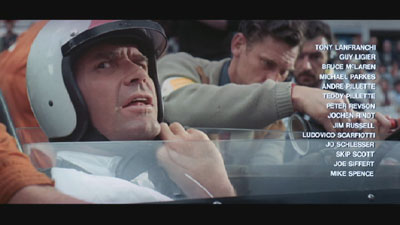
"You know what? Screw this. I got a pint and
a copy of Evilspeak back home."
Opening against the famed course in Monaco, Grand Prix presents the intertwined story of several hardnosed speed freaks – there’s the Jordan BRM-team of American Pete Aron (Garner) and his British teammate Scott Stoddard (Bedford) against the seasoned Ferrari Frenchman Jean-Pierre Sarti (Montand) and his Italian compatriot (Sabàto); each one on and off the tracks. Other race historians will be pleased to note the inclusion of luminaries like Phil and Graham Hill, Lorenzo Bandini, Bob Bondurant, Jack Brabham, and Jimmy Clark in the mix of the decisive quest to become a Formula One racer and win the 1966 World Championship.
Things get thrown a bit off kilter as Aron’s recklessness throws Stoddard into a wall at 180 mph, jettisoning his chances as BRM’s signature driver. Forced into becoming a Sportscaster (after being fished out of the Mediterranean), it’s only through the good graces of Mifune’s Yamura Industries that Aron has a chance to get back into the fray of each successive race before the season is over. Scott, sitting out months on the sidelines, is put in the awkward position of temporarily losing both his racing drive and his wife (Walter), who walks out on him and into Aron’s arms. Meanwhile, Sarti’s luck smiles upon him with each subsequent triumph and the inclusion of Marie Saint’s American photojournalist at his side. Just don’t tell that to his real wife. It’s mostly all for naught, as everyone heats up, culminating with the dust settling after each consecutive Grand Prix.
The Lowdown

"Dude, that H you gave me is working double overtime."
John Frankenheimer’s visionary work in such films as Seconds (where decades before Aronofsky, he and cinematographer extraordinaire James Wong Howe harnessed a camera onto a body for its desired warbled effect) and The Manchurian Candidate (with its probing psychological angles) cemented his creative prowess beyond the mere journeymen. In Grand Prix his edict was simple – “put the audience in the driver’s seat.” Rinse and repeat.
As a technical enterprise the mere words inspire more than a response for those engineers whose feats would surely to go into the record books. And work his team did until finally they were able to harness a 65mm Cinerama camera onto the front chassis of a Racecar. The results are nothing short of astounding, the ground whirring by faster than you’ve ever experienced; it feels real, you experience the rush of traveling faster than your hands during happy fun time. There is such force and it’s all quite on the level of the road that you almost feel as if your own teeth will be filed right off. That’s partly the brilliance of it. Frankenheimer insisted that his actors be filmed at the real speeds and not some sissy reaction of filming them traveling at lower speeds and then cranking the frames per second rate higher. No, sir. This is the real deal.
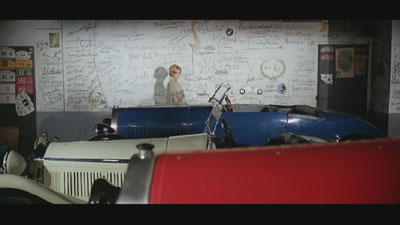
"Why, it’s almost as big as my dignity!"
That’s not even accounting for the other technical feats achieved with Frankenheimer’s signature camera angles, ones that are as forceful and imposing today as they were well over 40 years ago. There’s the now-rudimentary simple act of panning his Cinerama camera a mere 90 degrees to the left (exposing the car’s desired destination – of speed and the blurring of land) or to the right (bringing the centrifugal force smack-dab into the goggles of the racer himself) that creates a level of tension unparalleled to any race (besides Torque) in modern cinematic history. Edited together, it feels like a cohesive punch to your future children.
It’s a shame, though, that’s it’s naively balanced with the limpness of a drab dramatic story that infiltrates the rest of the plot. I almost feel that Grand Prix is two movies; the race and the dramatic uneasiness smashing together to create a muted fire that will still light the way. Written by Robert Alan Aurthur, the story contents itself in reveling in the racing sequences and bogging itself down in the haphazard underdramatic ones – situations that stem from the drivers themselves. There are many stories running parallel to the main one, each one nipping away slightly at the overall chance to give audiences a spectacle unlike anything they’d ever seen. Stoddard’s icy veneer in near-death gives way for a frosty one with the realizations that his wife, Pat, is acting as if she’s divorced by bounding into the temporary hotel rooms of ex-teammate (and future rival) Aron. Their relationship, while strained, isn’t a primary focal point, so it’s almost impossible to not issue a bedeviled sense of wonder when the movie progresses and finds itself with the happy couple reintegrated again – he as racer, she as doting wife. It’s mind-boggling.

"My pants sense is tingling…"
Garner’s Pete Aron is a cocky, stubborn, and driven misogynist who all but disappears for a good stretch of time, only to jump back into the final race at Monza with both tragedy and triumph. Garner, at best, had all but played out this role with much better audacity in films like Sturges’ Great Escape and in The Americanization of Emily. Here he’s relatively one-sided without much breathing room to explore what a man pawing around with another man’s not-quite-divorced wife would be thinking. There’s a brief glimpse of its ramifications, albeit a short one, that’s demolished once Stoddard finds the two of them together and asks politely for Aron to hit the bricks. There’s a sudden blink-and-you’ll-miss-it glance Garner does that shows the most promise in the entire film. Otherwise, his skill in the driving sequences, where he’s not so much Pete Aron as he is James Garner driving in Racecar getup, is overmatched by his muted abilities to stay afloat amongst the pedestrian-ness of outer drama.
Yves Montand, on the other hand, elevates his standard role as the senior one of the competitive group by the sheer nature of his alluring French accent. The lines of his face give way for his deep baritone and inverted stoicism, which is only matched with his debonair air outside of the track. There’s an unidentifiable history to his frame, and I’ve always tended to fill in my own blanks when breaking down his character. I sure as hell want Garner to whoop his ass up and down the asphalt, but I’ll be damned if a subconscious part of me wishes Montand would just take his own advice in the film’s concluding moments – he’s an enjoyable fraction of the movie. What turns his existence into mush is the pairing of Eva Marie Saint as his special lady friend (damn you dad, for ruining that word). The duo moves around one another like moths to a flame, but it has no resonance. She’s quickly in love with a married man who swears this relationship won’t be like the others. His wife shares only their business with him. And nothing else. So when the defining moments of their bond fracture, it doesn’t necessarily pack any punch. Squandered away in seemingly disinterested fragments, their desire for one another is at least more rounded than that of Stoddard and his wife.

"You must not forget that I can kill you."
As for Antonio Sabàto, his brash young upstart serves little to no purpose other than to waft in and out of the story when completely necessary, giving the other actors breathing time to do whatever it is they did off-screen. His skewed relationship with France’s own tres-jolie Françoise Hardy is nothing more than skimpy window dressing, paraded as a young, hip romance that meant less to me than the food I let go more than a few hours ago. It may be more pleasant-smelling, but it is what it is. Speaking of which, Toshirô Mifune’s accent is dubbed by the great character actor Paul Frees, and it’s incredibly noticeable. The scenes with both he and Garner recall my ill-fated attempts to make overseas 1-900 calls. It all ends in miscalculation.
What works every time is Frankenheimer’s adept visions at crafting some of the finest races ever put onto celluloid. You’ll see Grand Prix races at Monaco, French, Belgium’s Spa (complete with horrific cloudbursts), Netherlands, America’s Watson Cup, England’s bendy Brands Hatch, and Italy’s famed unforgiving Monza; courses with the same intensity as if you were rocketing along at ridiculous speeds. I’ve never seen Grand Prix in fullscreen (I searched for days to find a widescreen VHS copy) and I can’t even fathom what it means to be horrendously cropped from Frankenheimer’s original intent. Here, on the DVD, the breadth of scope is marvelous in commanding your own eyes front and center. His own edict rings 100% true. You are riding along with these crazies.
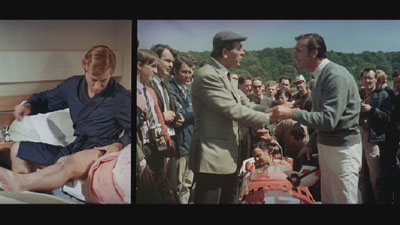
"Do you have any idea what’s going on behind you?"
Special note absolutely must be paid to the professional teams behind the camera, especially those in the sound department. Every squeal, shift, and engine rev is adequately pumped up and exploded outward for you to hear with reckless fury. Frankenheimer, working with a team of three editors, and famed montage maker Saul Bass, creates some interesting (if somewhat repetitive) split-screen montages that replicate the imagery onscreen double, triple, quadruple, sometimes magnified by 20. What it succeeds in accomplishing is creating the film’s rocketing rhythm that is unfortunately punctured with the overwrought dramatic stories that lack the excitement and freshness of the racing sequences. Bass’ abilities as a master craftsman do not go unnoticed, and in Grand Prix he manages to craft another wholly original sequence.
Composer Maurice Jarre, coming fresh off Doctor Zhivago (one of the greatest movies ever made), uses Zhivago-esque strings and harmonies to envelope the story in a haze of fairly buoyant melodies. Jarre’s main theme adroitly conjures up the musical feelings of racing coupled with the same excitement one would get being chased with a dead hooker in the backseat. Through his subtle use of motifs, there’s a plethora of seemingly romantic moments that made me weep faster than my time in the childhood cage.
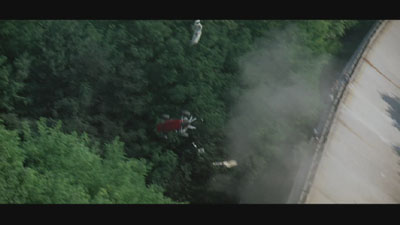
"F’ing Awesome! I launched that!"
Françoise Hardy, in the film, deadpans “it’s marvelous to go fast.” And truly, it is, especially with Frankenheimer’s technical feats propelling you at such entertaining speeds. It is not, however, awesome to experience the fleeting dramatic moments that protrude from the film like an oil slick during the final laps. In the end, Grand Prix is an enjoyable unbalanced film, just not a masterpiece.
The Package
Warner has gussied up a grenade of a Special Edition, blowing the washed-out VHS’ back into the analog realm. Presented in its original 2.20:1 Cinerama aspect ratio, this is the only way I can imagine seeing this film. It falls directly into the category of movies that must be experienced as shot, which also includes every movie ever made. It’s a bright and crisp transfer from original 65mm elements, although there are a few glaring scratches (like in the opening and end shots of the stands) and fading (Stoddard’s bedroom pan) is evident as well. The more welcomed addition is the inclusion of a 5.1 Dolby Digital track, which played with my set-up well and transferred the sound adequately, considering the movie was recorded in Stereo. Your front speakers will get busy while your back ones will recall those awkward times in High School with little play.

"All I did was push the inflate button. The doll did the rest."
Disc One has the theatrical trailer (runtime: 4:00), presenting a very mod post Academy Awards ‘speed and spectacle’ look. Incredibly noticeable is the lack of a good commentary track from anyone – from James Garner (who is still alive and kicking) to the various Racing Historians interviewed in the documentary, even the late Frankenheimer’s wife. It’s too bad one wasn’t recorded. It could have been fascinating.
All of the other extras are feature prominently on Disc Two. Up first is Pushing the Limit: The Making-of Grand Prix (runtime: 29:07). For the uninitiated, the documentary contains a wealth of interesting information, from archival footage of Frankenheimer back in the 60’s to a recent (and fragmented throughout the doc) Speed Channel interview done years before his untimely death. Cross-cut with the discussion there’s interviews with historians, racers, camera operators, and Actors of all types. The real meat of it rests within the stories told, from the archival footage of Garner yelling at a Monte Carlo shop keeper who wanted more money from the shoot to Frankenheimer recollecting the story of how he originally wanted Steve McQueen to play Pete Aron, but it fell through when the man he sent in his place quickly warmed to hate the masculine icon. McQueen would throw trash in neighbor Garner’s yard for the years following.
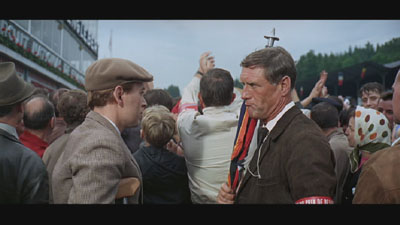
"Seriously, you know, that cross, man. What is up
with that? Just go on and be Jesus already."
Next is Flat Out: Formula One in the Sixites (runtime: 17:24). If you’ve ever wanted to see and in-depth discussion of racing in its golden era, then look no further. Talking torsos discuss the era with its gung-ho spirit versus the technological advances and commercialism that were banging into one another. But I feel that the entire documentary is summed up when someone states: “[there was] a lot of horsepower, very little brakes, and very little grip.”
The other doc, The Style and Sound of Speed (runtime: 11:39), goes into the mechanics of how Saul Bass worked in tandem with Frankenheimer to achieve the film’s signature sense of propulsion in its split-screens. There’s a brief topical talk about the sound guys learning all 452 gear shift changes in Monte Carlo and replicating that on a straightaway in Riverside, CA for the film as well as a look into Jarre’s ballet of machinery prevalent throughout most of the film.
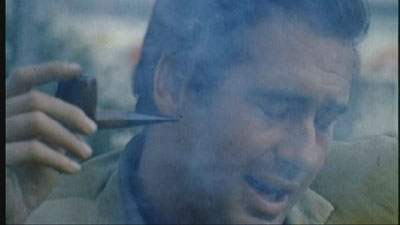
"Well, fuck."
The feature Brands Hatch: Chasing the Checkered Flag (runtime: 10:36) is a fairly ho-hum analysis of Britain’s premiere racing circuit. It’s more notable, to me anyway, for a talking head saying “big balls, if you like.” Consider me sold. Also included is a Speed Channel promotional short (runtime: 0:30) that is entirely superfluous.
Finally, there’s the vintage featurette Grand Prix: Challenge of the Champions (runtime: 12:45). Incorporating a surprisingly crisp and clean transfer, it’s a great feature to see some of the more elaborate camera rigs that the Grand Prix team crafted to create some of the film’s indelible imagery.